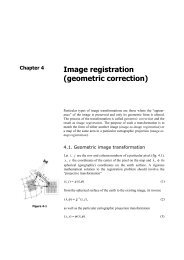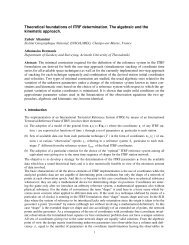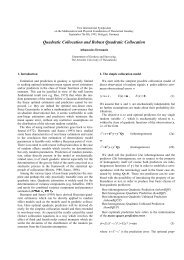Existing Landslide Monitoring Systems and Techniques
Existing Landslide Monitoring Systems and Techniques
Existing Landslide Monitoring Systems and Techniques
You also want an ePaper? Increase the reach of your titles
YUMPU automatically turns print PDFs into web optimized ePapers that Google loves.
quential self-pointing to a set of prism targets at predeterminedtime intervals, can measure distances <strong>and</strong>horizontal <strong>and</strong> vertical angles, <strong>and</strong> can transmit thedata to the office computer via a telemetry link.Similar systems are being developed by other manufacturersof surveying equipment. The robotic systemshave found many applications, particularly in monitoringhigh walls in open pit mining <strong>and</strong> in slope stabilitystudies. Generally, the accuracy of directionmeasurements with the self-pointing computerizedtheodolites is worse than the measurements withmanual pointing.Fig. 4. TCA2003 <strong>and</strong> TDM5005 motorized total stationsAs with any observational technique, total stationsystems have both advantages <strong>and</strong> disadvantages associatedwith their use. The main advantage of usingtotal station instruments is that they provide threedimensionalcoordinate information of the pointsmeasured. One of the disadvantages is the requirementto have an unobstructed line-of-sight betweenthe instrument <strong>and</strong> the targeting prism. Another disadvantageis that vertical refraction errors can reducethe accuracy of the height information that may beobtained from the total station measurements.Recently, a few models of EDM instruments with ashort pulse transmission <strong>and</strong> direct measurement ofthe propagation time have become available. Theseinstruments, having a high energy transmitted signal,may be used without reflectors to measure short distances(up to 200 m) directly to walls or natural flatsurfaces with an accuracy of about 10 millimeters. Anexample is the Leica DIOR 3002 EDM instrument.Reflectorless total stations have also been introduced<strong>and</strong> can be used in some cases for l<strong>and</strong>slide monitoring.However, the accuracy of distance measurementdepends upon the repeatability <strong>and</strong> reflective propertiesof the targeting surface or object.It must be pointed out that electronic total station instrumentshave largely replaced older instruments <strong>and</strong>techniques, such as theodolites <strong>and</strong> EDM instrumentsin many surveying applications.2.4 Satellite-based geodetic techniques forl<strong>and</strong>slide monitoringThe Global Positioning System (GPS) can be used asan alternative surveying tool to assist in geotechnicalevaluations of steep slopes by providing 3D coordinatetime series of displacements at discrete points onthe sliding surface (fig. 5). Current GPS positioningtechniques for monitoring applications typically includethe use of either episodic techniques for smallscaleprojects or continuous monitoring for regionalscale projects. Each of these techniques has associatedtrade-offs between system installation <strong>and</strong> maintenancecosts, <strong>and</strong> the quality of the resulting coordinatetime-series.GPS positioning is based on measuring the transittime of radio signals emitted by orbiting satellites. Fora receiver to compute its st<strong>and</strong>-alone position, it mustbe in view of at least four satellites. Code Phase Positioningis widely used in navigation <strong>and</strong> low accuracytracking applications, <strong>and</strong> relies on the measurementof the modulated GPS signal code phase, which exhibitsa resolution of about 1m. The measurement isaffected by several perturbations, which bring theachievable accuracy to about 5-10m.GPS offers advantages over conventional terrestrialmethods. Visibility among stations is not strictly necessary,allowing greater flexibility in the selection ofstation locations than for terrestrial geodetic surveys.Measurements can be taken during night or day, undervarying weather conditions, which makes GPS measurementseconomical, especially when multiple receiverscan be deployed on the deforming mass duringthe survey.The accuracy of GPS relative positioning dependson the distribution (positional geometry) of the observedsatellites <strong>and</strong> on the quality of the observations.Several major sources of error contaminatingthe GPS measurements are:1. Signal propagation errors--tropospheric <strong>and</strong> ionosphericrefraction, <strong>and</strong> signal multipath2. Receiver related errors--antenna phase center variation,<strong>and</strong> receiver system noise– 249 –






